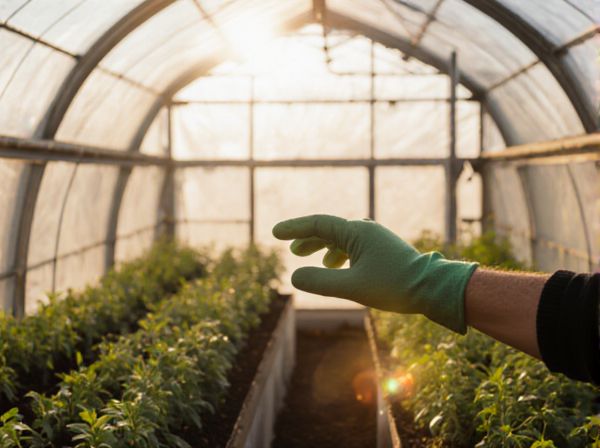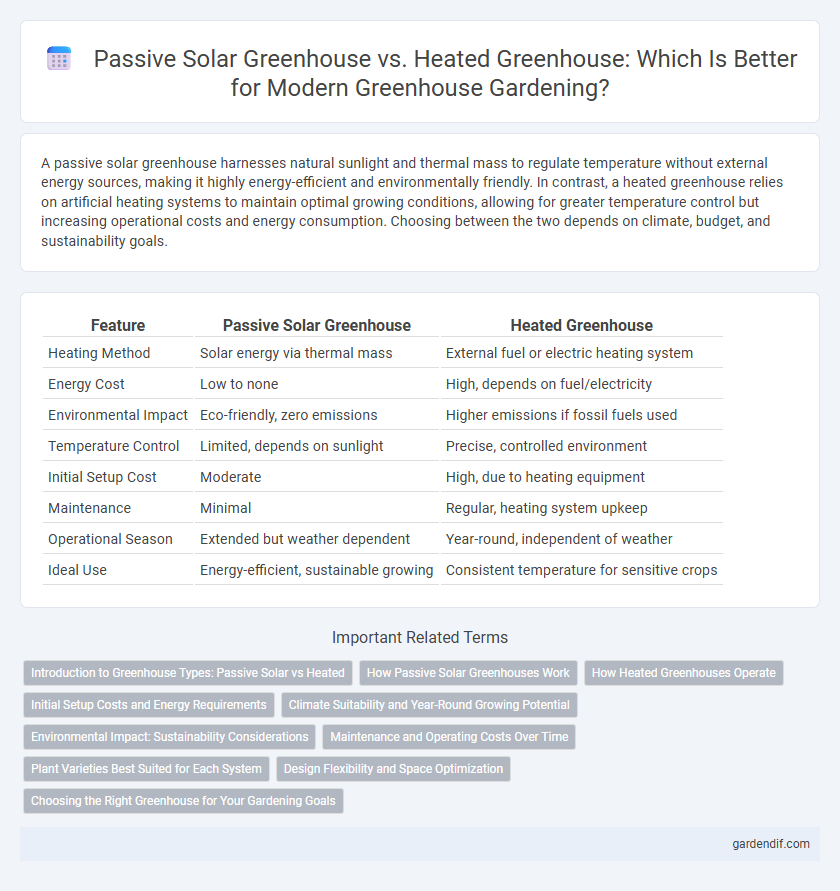
Passive solar greenhouse vs heated greenhouse Illustration
A passive solar greenhouse harnesses natural sunlight and thermal mass to regulate temperature without external energy sources, making it highly energy-efficient and environmentally friendly. In contrast, a heated greenhouse relies on artificial heating systems to maintain optimal growing conditions, allowing for greater temperature control but increasing operational costs and energy consumption. Choosing between the two depends on climate, budget, and sustainability goals.
Table of Comparison
| Feature | Passive Solar Greenhouse | Heated Greenhouse |
|---|---|---|
| Heating Method | Solar energy via thermal mass | External fuel or electric heating system |
| Energy Cost | Low to none | High, depends on fuel/electricity |
| Environmental Impact | Eco-friendly, zero emissions | Higher emissions if fossil fuels used |
| Temperature Control | Limited, depends on sunlight | Precise, controlled environment |
| Initial Setup Cost | Moderate | High, due to heating equipment |
| Maintenance | Minimal | Regular, heating system upkeep |
| Operational Season | Extended but weather dependent | Year-round, independent of weather |
| Ideal Use | Energy-efficient, sustainable growing | Consistent temperature for sensitive crops |
Introduction to Greenhouse Types: Passive Solar vs Heated
Passive solar greenhouses utilize natural sunlight and thermal mass materials to maintain temperature without external energy sources, making them energy-efficient and environmentally friendly. Heated greenhouses rely on supplemental heating systems such as electric heaters, gas boilers, or radiant heat to provide consistent temperature control regardless of outside weather conditions. Understanding these differences helps optimize crop production by aligning greenhouse type with climate, energy availability, and plant requirements.
How Passive Solar Greenhouses Work
Passive solar greenhouses harness sunlight through south-facing windows and thermal mass materials that store heat during the day and release it at night, maintaining stable internal temperatures. This natural energy regulation reduces or eliminates the need for external heating systems, making them highly energy-efficient and cost-effective for year-round plant growth. Unlike heated greenhouses, passive solar designs optimize orientation, insulation, and ventilation to maximize solar gain and minimize heat loss.
How Heated Greenhouses Operate
Heated greenhouses use supplemental energy sources such as electric heaters, gas furnaces, or hot water systems to maintain optimal temperatures for plant growth regardless of external weather conditions. These systems are often integrated with thermostats and automated controls to ensure consistent climate regulation and prevent heat loss. Unlike passive solar greenhouses that rely primarily on solar energy and insulation, heated greenhouses provide precise environmental control essential for year-round cultivation.
Initial Setup Costs and Energy Requirements
Passive solar greenhouses have lower initial setup costs due to their reliance on natural sunlight and thermal mass for heating, minimizing the need for complex heating systems. Heated greenhouses require significant investment in heating equipment and insulation to maintain controlled temperatures, leading to higher energy consumption and ongoing operational expenses. Evaluating energy efficiency and budget constraints is essential when choosing between passive solar and heated greenhouse designs.
Climate Suitability and Year-Round Growing Potential
Passive solar greenhouses rely on natural sunlight and thermal mass to maintain stable temperatures, making them highly suitable for temperate climates with ample sun exposure. Heated greenhouses use supplemental energy sources such as electric or gas heaters, enabling year-round growing potential even in colder, less sunny regions. Choosing between the two depends on regional climate patterns and the desired consistency of crop production throughout all seasons.
Environmental Impact: Sustainability Considerations
Passive solar greenhouses leverage natural sunlight and thermal mass to minimize energy consumption, significantly reducing carbon emissions and reliance on fossil fuels. Heated greenhouses, while allowing more controlled growing conditions, often depend on external energy sources, increasing their environmental footprint due to fossil fuel usage and associated greenhouse gas emissions. Sustainable greenhouse design prioritizes maximizing passive solar gain and insulation to reduce heating requirements and promote eco-friendly food production.
Maintenance and Operating Costs Over Time
Passive solar greenhouses minimize maintenance and operating costs by utilizing natural sunlight and thermal mass to regulate temperature, reducing the need for external energy sources. Heated greenhouses require ongoing fuel or electricity expenses and regular upkeep of heating systems, significantly increasing long-term operational expenses. Over time, passive solar greenhouses offer more cost-effective solutions for sustainable plant growth with lower environmental impact.
Plant Varieties Best Suited for Each System
Passive solar greenhouses favor Mediterranean herbs, succulents, and cold-hardy vegetables such as kale and spinach, benefiting from natural heat retention and consistent sunlight exposure. Heated greenhouses support tropical plants, orchids, and frost-sensitive fruits like bananas and papayas, providing controlled temperature and humidity levels year-round. Selecting plant varieties aligned with each greenhouse system optimizes growth, energy efficiency, and crop yield.
Design Flexibility and Space Optimization
Passive solar greenhouses utilize strategic orientation, thermal mass, and insulation to maximize natural heat retention, enabling flexible design layouts that optimize space without relying on external energy. Heated greenhouses integrate mechanical heating systems, allowing more consistent climate control but often requiring dedicated space for equipment, which can limit design adaptability and reduce usable growing areas. Optimizing greenhouse design involves balancing the spatial demands of heating infrastructure against the passive solar approach's potential for efficient space utilization and energy savings.
Choosing the Right Greenhouse for Your Gardening Goals
Passive solar greenhouses harness natural sunlight and thermal mass to maintain warmth, reducing energy costs and promoting sustainable gardening. Heated greenhouses rely on external heating systems to extend growing seasons and support temperature-sensitive plants in colder climates. Selecting the right greenhouse involves evaluating climate conditions, plant types, and energy consumption priorities to optimize growth and cost efficiency.
Passive solar greenhouse vs heated greenhouse Infographic

 gardendif.com
gardendif.com